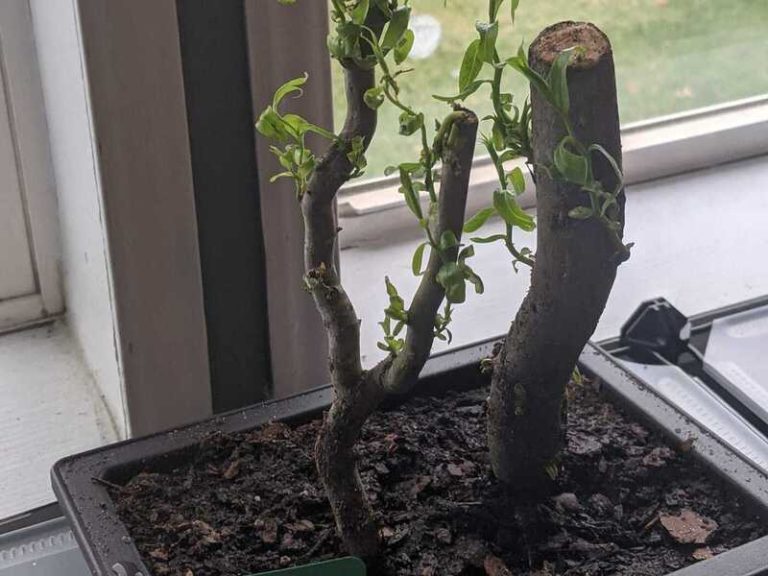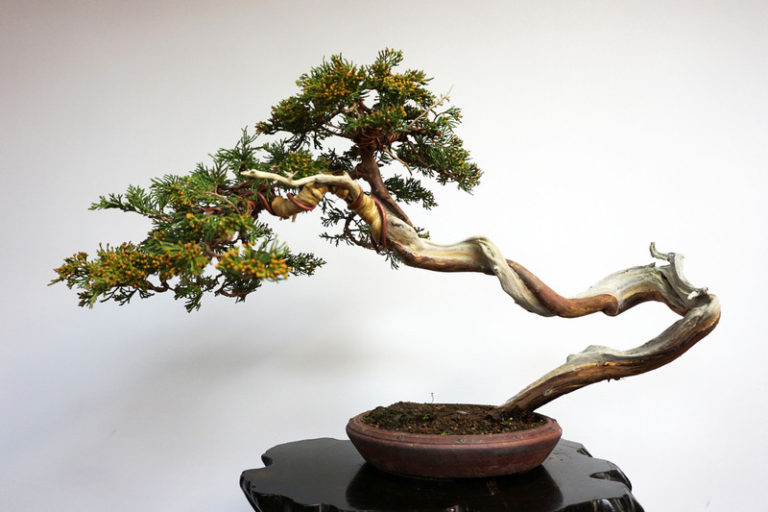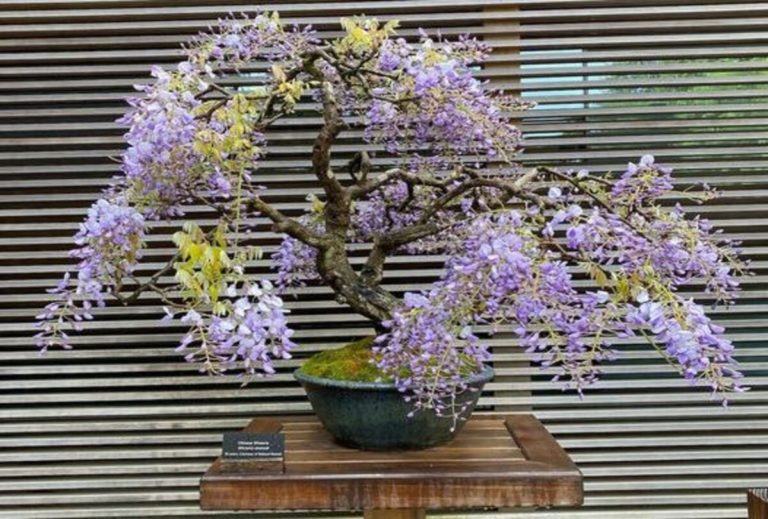Bonsai Ficus Benghalensis: A Miniature Tree with Majestic Charm
Bonsai trees are small versions of their larger cousins that have been carefully grown and shaped to create live works of art. The banyan tree, which is also known as Ficus benghalensis, is a favorite choice for bonsai fans. In this article, we’ll look at the world of bonsai, or Ficus benghalensis, and give simple, useful advice on how to grow and care for these beautiful tiny fig trees.
What is Bonsai Ficus Benghalensis?
Bonsai Ficus benghalensis is a type of the banyan tree, Ficus benghalensis, that is grown and made like a bonsai tree. It comes from India and Southeast Asia. As a bonsai, it is pruned and taught to look like a smaller version of the bigger tree. People like bonsai Ficus Benghalensis because it has pretty leaves, airy roots, and can grow a thick trunk. It is a strong and flexible tree, which makes it a good choice for bonsai.
History and Origins of the Bonsai Ficus Benghalens
The Bonsai Ficus Benghalensis has its roots in the old art of bonsai, which started in China more than a thousand years ago. Bonsai is the art of growing and shaping small trees or plants to look like works of art.
The Ficus Benghalensis, also known as the banyan tree, is a tree that grows in India. It is well-known for its classic look, with its long branches, aerial roots, and huge trunk. In India, the banyan tree is important to culture and religion, and it has been worshiped as a sign of power, long life, and how everything is linked.
Bonsai was brought from China to Japan in the sixth century, where it flourished and acquired popularity. Japanese bonsai artists refined the aesthetics and techniques of bonsai, influencing the development and diversity of bonsai species.
It was during this time that Ficus Benghalensis, with its distinctive characteristics, caught the attention of bonsai enthusiasts. The banyan tree’s ability to develop aerial roots and a thick trunk made it an ideal candidate for bonsai cultivation.
As the discipline of bonsai extended to many regions of the world, including Europe and America, the Bonsai Ficus Benghalensis earned popularity and acceptance among bonsai aficionados. Because of its remarkable look and aesthetic capabilities, it is now one of the most popular options for bonsai growing.
The history and origins of the Bonsai Ficus Benghalensis showcase the cross-cultural exchange and artistic evolution that bonsai have undergone over the centuries. It continues to captivate and inspire bonsai artists and enthusiasts worldwide, preserving the beauty and artistry of nature in miniature form.
Bonsai Ficus Benghalens and Their Symbolism
Bonsai Ficus Benghalensis, like any bonsai tree, carries symbolic meaning that adds depth and significance to its presence. Here are some symbolic interpretations associated with Bonsai Ficus Benghalensis:
Strength and Resilience: The Ficus Benghalensis is known for its strong and sturdy trunk, which represents resilience and the ability to withstand challenges. It symbolizes inner strength, adaptability, and the power to endure.
Longevity and Timelessness: Bonsai Ficus Benghalensis, with its long lifespan and slow growth, embodies the concept of timelessness. It serves as a reminder of the wisdom and beauty that can be found in the passing of years and the patience required to nurture and care for something over time.
Interconnectedness and Unity: The Bonsai Ficus Benghalensis, with its intricate network of aerial roots, symbolizes interconnectedness and unity. It represents the harmony and interdependence of all living beings, highlighting our connection to nature and the world around us.
Balance and Harmony: Bonsai Ficus Benghalensis, when carefully shaped and pruned, exemplifies the concept of balance and harmony. Its symmetrical and well-proportioned form reflects the quest for balance in our own lives, reminding us to find equilibrium and beauty in all aspects of life.
Meditation and Serenity: Bonsai Ficus Benghalensis has a calming presence and is often associated with meditation and serenity. The contemplative nature of bonsai cultivation, combined with the tree’s peaceful aesthetics, can create a serene and tranquil environment.
Beauty in Imperfection: Bonsai Ficus Benghalensis, just like any bonsai tree, embraces the concept of Wabi-sabi, finding beauty in imperfection and embracing the natural, aged qualities of the tree. It encourages us to appreciate the unique character and journey of each individual tree.
These symbolic interpretations are not limited to Bonsai Ficus Benghalensis alone but can be attributed to bonsai as a whole. The symbolism associated with bonsai enriches the experience of cultivating and admiring these miniature trees, providing a deeper connection to nature and profound contemplation.
Characteristics of the Bonsai Ficus Benghalens
The Bonsai Ficus Benghalensis, which is also called the banyan tree, has several unique qualities that make it a popular choice among bonsai fans. Some important things about the Bonsai Ficus Benghalensis are:
Aerial Roots: One of the most recognizable traits of the Bonsai Ficus Benghalensis is its aerial roots. These roots grow from the branches and descend towards the ground, giving the tree a unique and striking appearance. The aerial roots can be incorporated into the bonsai design, adding to its aesthetic appeal.
Massive Canopy: The Bonsai Ficus Benghalensis has a large and sprawling canopy with glossy, dark green leaves. The dense foliage provides a lush and vibrant visual display, creating a sense of fullness and maturity in the bonsai tree.
Strong Trunk: Over time, the trunk of the Bonsai Ficus Benghalensis develops a thick and sturdy structure. The trunk exhibits interesting texture and character, with visible fluting and bark patterns that enhance the overall aesthetic value of the tree.
Growth Potential: Ficus Benghalensis has the ability to grow rapidly, both in terms of foliage and aerial roots. This growth potential allows bonsai enthusiasts to create intricate and intricate designs, manipulating the tree’s shape and form according to their artistic vision.
Adaptability: The adaptability of the Bonsai Ficus Benghalensis to varied growth environments is well documented. It can grow in both indoor and outdoor conditions if given enough light, water, and attention. Because of its adaptability, it is suited for bonsai development in a variety of climates and locales.
Longevity: With proper care, the Bonsai Ficus Benghalensis can live for many years, even decades. Its long lifespan allows bonsai artists to witness the tree’s growth and transformation over time, adding a sense of connection and continuity to the bonsai experience.
These characteristics of the Bonsai Ficus Benghalensis contribute to its allure as a bonsai tree. Its aerial roots, dense foliage, strong trunk, growth potential, adaptability, and longevity make it a fascinating and rewarding choice for bonsai enthusiasts who appreciate its unique features and artistic possibilities.
Types of Bonsai Ficus Benghalens
There are several types or styles of Bonsai Ficus Benghalensis that bonsai enthusiasts can explore and create. Here are some popular types:
Formal Upright Style (Chokkan): This style represents the classic upright form, with a straight trunk tapering towards the apex. The branches are arranged in a balanced and symmetrical manner, giving the tree a formal and elegant appearance.
Informal Upright Style (Moyogi): In this style, the trunk of the Bonsai Ficus Benghalensis exhibits gentle curves and movements, simulating the organic growth of a mature tree. The branches are irregularly arranged, providing a more natural and informal aesthetic.
Slanting Style (Shakan): The Slanting Style features a trunk that slants to one side, creating a dynamic and visually captivating bonsai. The branches emerge from the slanted trunk at different angles, contributing to the overall asymmetrical look of the tree.
Cascade Style (Kengai): The Cascade Style mimics a tree growing on the side of a mountain or cliff. The trunk cascades downward, often extending below the pot level, giving the impression of a tree clinging to a steep slope. This style evokes a sense of drama and movement.
Banyan Style (Ikadabuki): This style emphasizes the aerial roots of the Bonsai Ficus Benghalensis. The aerial roots are allowed to develop and grow extensively, creating a visually striking and intricate design. The roots can be trained to cascade down from the branches, further enhancing the banyan tree-like appearance.
Group Planting Style (Yose-ue): This style involves planting multiple Bonsai Ficus Benghalensis trees together, creating a forest or group composition. The trees are carefully arranged to mimic a natural woodland setting, with varying heights, trunk thickness, and branch structures. This style conveys a sense of unity and harmony among the trees.
These are just a few examples of the types of Bonsai Ficus Benghalensis that can be created. Bonsai artists and enthusiasts have the freedom to experiment and explore their creativity, combining different styles and techniques to develop their unique interpretations of the Bonsai Ficus Benghalensis.
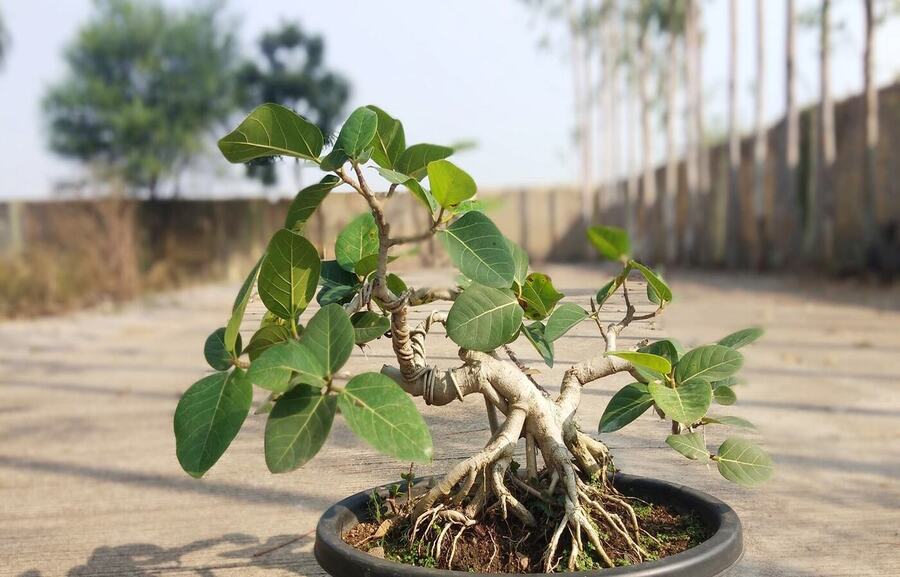
How to Grow a Bonsai Ficus Benghalens
Growing a Bonsai Ficus Benghalensis requires patience, attention to detail, and proper care. Here is a step-by-step guide on how to grow and cultivate a Bonsai Ficus Benghalensis:
1. Selection and Preparation:
- Choose a healthy Bonsai Ficus Benghalensis tree from a reputable nursery or start from a cutting.
- Select a suitable bonsai pot or container with good drainage holes.
- Prepare a well-draining bonsai soil mix, which is typically a blend of organic and inorganic components.
2. Repotting:
- Carefully remove the Bonsai Ficus Benghalensis from its current pot, gently loosening the roots.
- Trim back any excessively long or tangled roots.
- Place the tree in the new bonsai pot, ensuring it is centered and at the desired height.
- Fill the pot with the bonsai soil mix, carefully working it around the roots to eliminate air pockets.
3. Placement and Lighting:
- Position the Bonsai Ficus Benghalensis in a location that receives bright, indirect sunlight. Avoid placing it in direct sunlight, as it can scorch the leaves.
- If growing indoors, ensure it receives sufficient light, such as near a bright window or under grow lights.
4. Watering:
- Water the Bonsai Ficus Benghalensis thoroughly whenever the top layer of soil feels slightly dry to the touch.
- Water until it drains out of the bottom of the pot, ensuring proper hydration.
- Avoid overwatering or allowing the soil to become waterlogged, as it can lead to root rot.
5. Fertilization:
- Apply a balanced, water-soluble fertilizer specifically formulated for bonsai, following the instructions on the package.
- Fertilize during the growing season, typically from spring to fall, at regular intervals (e.g., every two weeks or as directed).
6. Pruning and Shaping:
- Regularly prune the Bonsai Ficus Benghalensis to maintain its shape and desired form.
- Use sharp and clean bonsai pruning tools to trim back new growth, maintain compactness, and encourage ramification.
- Remove any dead, damaged, or diseased branches or foliage promptly.
7. Wiring and Training:
- Use bonsai wire to shape and train the branches of the Bonsai Ficus Benghalensis.
- Wrap the wire gently around the branches, carefully bending and positioning them into the desired shape.
- Monitor the growth regularly and adjust or remove the wiring as needed to avoid wire cutting into the bark.
8. Protection and Care:
- Protect the Bonsai Ficus Benghalensis from extreme temperatures, both cold and hot.
- Keep an eye out for pests and diseases, such as scale insects or fungal infections, and take appropriate measures to address them promptly.
9. Continued Maintenance:
- Regularly inspect the Bonsai Ficus Benghalensis for any signs of stress, such as yellowing leaves or root issues, and address them accordingly.
- Periodically repot the bonsai every few years to refresh the soil and promote root health.
Remember, growing a Bonsai Ficus Benghalensis is an ongoing process that requires consistent care, patience, and attention. By providing the right conditions, proper watering, pruning, and training, you can nurture a beautiful and healthy Bonsai Ficus Benghalensis tree over time.
Benefits of the Bonsai Ficus Benghalensis
The Bonsai Ficus Benghalensis, or banyan tree, offers several benefits to bonsai enthusiasts and those who appreciate its beauty. Here are some key benefits of cultivating the Bonsai Ficus Benghalensis:
- Aesthetic Appeal: The Bonsai Ficus Benghalensis is visually captivating and adds a touch of natural elegance to any space. Its sprawling branches, glossy leaves, and aerial roots create a unique and eye-catching display. It serves as a living work of art, enhancing the aesthetic appeal of gardens, homes, offices, and indoor spaces.
- Stress Reduction: Bonsai cultivation, including the care and shaping of the Bonsai Ficus Benghalensis, can be a therapeutic and stress-relieving activity. Engaging with nature, practicing patience, and focusing on the intricacies of bonsai care can promote relaxation, mindfulness, and a sense of calm.
- Connection with Nature: The Ficus Benghalensis Bonsai enables individuals to communicate with nature on a more intimate scale. It serves as a reminder of the splendor and marvels of the natural world despite being a diminutive tree. Caring for a bonsai tree can enhance one’s appreciation and comprehension of the cycles and growth processes of nature.
- Indoor Greenery: The Bonsai Ficus Benghalensis can be successfully grown indoors, bringing a touch of greenery and nature to spaces that may lack outdoor garden areas. It adds a refreshing and vibrant element to living rooms, offices, and other indoor environments, improving air quality and creating a more inviting atmosphere.
- Personal Growth and Patience: The care of a Bonsai Ficus Benghalensis necessitates fortitude, discipline, and meticulousness. The process of providing for a bonsai tree can teach valuable life lessons such as perseverance, discipline, responsibility, and the ability to recognize the value of long-term efforts. Individuals are able to cultivate a deeper connection with the natural world and partake in personal development.
- Conversation Starter: The unique and artistic nature of the Bonsai Ficus Benghalensis often sparks conversations and intrigue among visitors. It serves as an interesting focal point, inviting discussions about bonsai cultivation, the art of bonsai, and the beauty of nature.
While the benefits of the Bonsai Ficus Benghalensis extend beyond this list, these points highlight the aesthetic, therapeutic, and personal growth advantages associated with cultivating and appreciating this captivating bonsai tree.
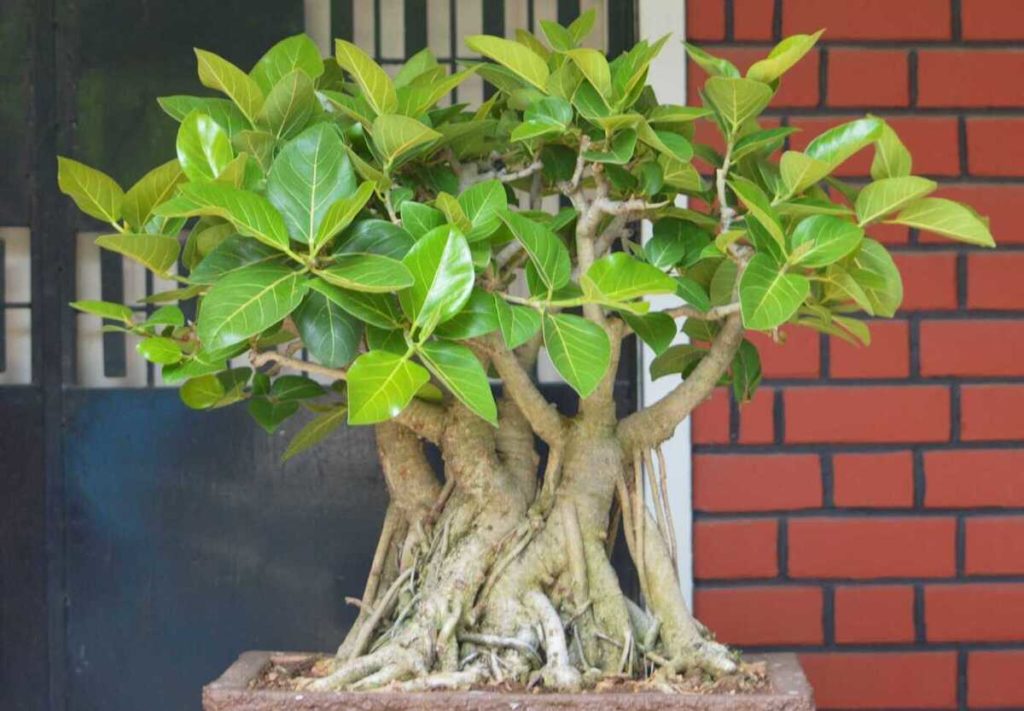
Displaying Bonsai Ficus Benghalensis
Displaying a Bonsai Ficus Benghalensis involves creating an environment that showcases its beauty and emphasizes its unique features. Here are some tips for displaying your Bonsai Ficus Benghalensis:
1. Choice of Stand or Table: Select a suitable stand, table, or bonsai display area that complements the size and style of your Bonsai Ficus Benghalensis. Consider using a traditional bonsai stand made of wood or a sturdy, aesthetically pleasing table.
2. Placement: Find a well-lit area for your Bonsai Ficus Benghalensis. It should receive bright, indirect sunlight for several hours a day. Avoid placing it in direct sunlight, as it can cause leaf burn. Indoors, choose a spot near a bright window, and outdoors, select a location with partial shade.
3. Background: Consider the backdrop against which you’ll display your Bonsai Ficus Benghalensis. A clean, uncluttered background can help highlight the tree’s form and foliage. A solid-colored wall, a backdrop of bamboo fencing, or a neutral-toned background can provide a visually pleasing setting.
4. Stand Placement: Position the bonsai stand or table at an appropriate height for easy viewing and to ensure the Bonsai Ficus Benghalensis is at eye level. This allows viewers to appreciate the tree’s details and overall form without straining their necks.
5. Group Display: If you have multiple Bonsai Ficus Benghalensis or other bonsai trees, consider creating a group display. Arrange them together on a display table, creating a miniature landscape or forest setting. Pay attention to varying heights, shapes, and textures to achieve a balanced and harmonious composition.
6. Accent Plants and Decorations: Enhance the display of your Bonsai Ficus Benghalensis with carefully chosen accent plants or small decorative items. These can include moss, rocks, miniature figurines, or small ornaments that complement the overall aesthetics of the bonsai tree.
7. Rotating the Tree: Periodically rotate your Bonsai Ficus Benghalensis to ensure balanced growth and prevent the tree from leaning towards one direction. This helps expose all sides of the tree to light and allows viewers to appreciate the tree from different angles.
8. Regular Maintenance: Keep the display area clean and free of debris. Regularly inspect the bonsai for any signs of pests, diseases, or grooming needs. Prune back overgrown branches, remove dead leaves, and ensure the overall appearance of the tree is well-maintained.
Remember, the goal of displaying your Bonsai Ficus Benghalensis is to showcase its natural beauty and artistic form. With careful consideration of placement, lighting, background, and regular maintenance, you can create an appealing and visually captivating display that highlights the unique qualities of your bonsai tree.
Styling and Design of a Bonsai Ficus Benghalensis
The styling and design of a Bonsai Ficus Benghalensis involve shaping the tree to create a visually appealing and balanced composition. Here are some considerations and techniques for styling and designing your Bonsai Ficus Benghalensis:
Research and Planning: Before starting the styling process, study the natural growth patterns of the Ficus Benghalensis tree and explore different bonsai styles. Understand the characteristics of the tree species and determine the desired style or vision for your bonsai.
Trunk Selection: Select a main trunk that has desirable characteristics, such as thickness, movement, and taper. The trunk should convey a sense of age and maturity. Choose a trunk that aligns with your desired bonsai style, whether formal upright, informal upright, slanting, cascade, or another style.
Branch Development: Encourage the development of primary, secondary, and tertiary branches to create a well-structured and balanced bonsai. Allow the branches to grow freely and periodically prune them back to promote ramification and a compact canopy.
Wiring and Shaping: Use bonsai wire to shape and position the branches according to your desired design. Wrap the wire carefully around the branches, starting from the trunk and working outwards. Gently bend the branches into desired positions, considering the overall composition and natural growth patterns of the tree.
Pruning and Maintenance: Regularly prune back new growth, maintain the desired shape, and remove any dead, damaged, or unwanted branches. Pruning helps refine the silhouette and promotes back budding, leading to denser foliage.
Aerial Roots: If your Bonsai Ficus Benghalensis develops aerial roots, incorporate them into the design by positioning them in an aesthetically pleasing way. These roots can be trained to cascade down from branches or to wrap around the trunk, adding visual interest and a sense of maturity to the bonsai.
Pot Selection: Choose an appropriate bonsai pot that complements the style and size of your Bonsai Ficus Benghalensis. Consider the color, shape, and material of the pot to enhance the overall presentation. The pot should provide stability and balance to the tree.
Display Considerations: When selecting a display location for your bonsai, ensure it enhances the overall aesthetics. Consider the backdrop, lighting, and surrounding elements to create a harmonious and visually pleasing arrangement.
Remember, styling a Bonsai Ficus Benghalensis is an ongoing process that requires patience and continuous refinement. It’s important to strike a balance between your artistic vision and the natural characteristics of the tree. With time, care, and attention, you can create a stunning and unique bonsai that reflects your personal style and admiration for the beauty of nature.
How to Care for and Maintain a Bonsai Ficus Benghalensis
Caring for and maintaining a Bonsai Ficus Benghalensis is crucial to ensure its health, growth, and longevity. Here are some essential care guidelines to follow:
- Watering: The watering needs of a Bonsai Ficus Benghalensis can vary depending on factors like climate, pot size, and humidity. Water the tree thoroughly when the top inch of soil feels slightly dry. Avoid overwatering or allowing the soil to become waterlogged, as it can lead to root rot. Ensure proper drainage by using a well-draining bonsai soil mix and a pot with drainage holes.
- Sunlight and Temperature: Bonsai Ficus Benghalensis thrives in bright, indirect sunlight. Place your bonsai in a location that receives several hours of sunlight each day. Avoid exposing it to direct sunlight for extended periods, as it can scorch the leaves. Protect the tree from extreme temperatures, as it prefers a temperate climate between 65-85°F (18-29°C).
- Humidity: Bonsai Ficus Benghalensis appreciates higher humidity levels. You can increase humidity by misting the leaves regularly or placing the bonsai on a humidity tray filled with water and pebbles. Avoid placing the tray directly under the pot to prevent water absorption through the drainage holes.
- Fertilization: Feed your Ficus Benghalensis tree with a balanced, water-soluble fertilizer made for bonsai plants. Follow the directions on the box and use the fertilizer when the plants are growing, usually from spring to fall. During the winter, when the tree goes dormant, cut back on or stop fertilizing it.
- Pruning and Shaping: Regular pruning is essential to maintain the shape and compactness of your bonsai. Trim back new growth to encourage ramification and a denser canopy. Remove any dead, damaged, or diseased branches promptly. Use clean and sharp bonsai pruning tools to prevent the spread of diseases.
- Wiring and Training: Wiring allows you to shape and position the branches of your Bonsai Ficus Benghalensis. Apply bonsai wire carefully to avoid damaging the bark and remove it once the branch has set in the desired position. Regularly monitor the wire to prevent it from cutting into the bark as the tree grows.
- Repotting: Bonsai Ficus Benghalensis should be repotted every 2-3 years to refresh the soil and promote healthy root growth. Repotting is typically done in early spring before the tree enters a vigorous growth phase. Trim back the roots and replace the soil with a fresh bonsai soil mix. Prune back the foliage after repotting to reduce stress on the tree.
- Pest and Disease Control: Regularly inspect your Bonsai Ficus Benghalensis for signs of pests like scale insects or fungal diseases. Treat any issues promptly using appropriate methods or consult a horticulture expert for guidance.
- Observing and Adjusting: Observe your bonsai closely for any signs of stress, such as yellowing leaves, wilting, or root problems. Adjust your care routine accordingly by fine-tuning watering, light exposure, or humidity levels to meet the tree’s specific needs.
By providing proper care, attention, and regular maintenance, you can ensure the health and vitality of your Bonsai Ficus Benghalensis, allowing it to thrive and showcase its beauty for years to come.
Bonsai Ficus Benghalensis Care Sheet
| Aspect | Care Tips |
| Watering | Water thoroughly when the top inch of soil is slightly dry. Avoid overwatering and ensure proper drainage. |
| Sunlight | Place in bright, indirect sunlight for several hours a day. Avoid prolonged exposure to direct sunlight. |
| Temperature | Maintain a temperate climate between 65-85°F (18-29°C). Avoid extreme temperatures and drafts. |
| Humidity | Increase humidity through misting or using a humidity tray with water and pebbles. |
| Fertilization | Use a balanced, water-soluble bonsai fertilizer during the growing season. Follow instructions on the package. |
| Pruning and Trimming | Regularly prune back new growth and remove dead or damaged branches. Maintain the desired shape and density. |
| Wiring and Styling | Use bonsai wire to shape branches carefully, avoiding damage to the bark. Monitor and adjust wiring as needed. |
| Repotting | Repot every 2-3 years using a fresh bonsai soil mix. Trim back roots and prune foliage after repotting. |
| Pest and Disease Control | Regularly inspect for pests and signs of diseases. Treat promptly using appropriate methods or seek expert help. |
| Winter Care | Protect from frost and extreme cold. Reduce watering and fertilization during the dormant period. |
| Regular Maintenance | Observe and adjust care routine based on the tree’s needs. Monitor for signs of stress and take necessary steps. |
Remember to adapt the care routine based on your specific Bonsai Ficus Benghalensis, as individual trees may have unique requirements. Regularly monitor the tree’s health, make adjustments as needed, and provide the appropriate care and attention to keep your bonsai thriving.
Conclusion
Growing and caring for a Ficus benghalensis bonsai can be a rewarding and enjoyable experience. By following these simple guidelines, you can create a stunning miniature fig tree that will captivate and inspire. Embrace the art of bonsai with Ficus benghalensis and let nature’s beauty thrive in your own hands. Happy bonsai gardening!
FAQ
Q: What is a Bonsai Ficus Benghalensis?
A: Bonsai Ficus Benghalensis, also known as the banyan tree, is a popular bonsai tree species known for its aerial roots, glossy leaves, and elegant appearance. It is a tropical tree native to India and Southeast Asia.
Q: Can I keep a Bonsai Ficus Benghalensis indoors?
A: Yes, Bonsai Ficus Benghalensis can be kept indoors, but it requires bright, indirect sunlight. Place it near a window or in a well-lit room. Ensure proper watering and humidity levels to maintain its health.
Q: How often should I water my Bonsai Ficus Benghalensis?
A: Watering frequency depends on factors like climate, pot size, and humidity. As a general guideline, water the tree thoroughly when the top inch of soil feels slightly dry. Avoid overwatering, which can lead to root rot.
Q: Does a Bonsai Ficus Benghalensis require special fertilizer?
A: Bonsai Ficus Benghalensis benefits from regular fertilization. Use a balanced, water-soluble bonsai fertilizer during the growing season. Follow the instructions on the package for dosage and application frequency.
Q: How often should I prune my Bonsai Ficus Benghalensis?
A: Pruning requirements vary based on the tree’s growth and desired shape. Regularly trim back new growth to maintain the shape and density of the bonsai. Prune dead or damaged branches promptly.
Q: Can I wire and style a Bonsai Ficus Benghalensis?
A: Yes, you can wire and style a Bonsai Ficus Benghalensis. Use bonsai wire to shape and position the branches carefully. Monitor the wire to prevent it from cutting into the bark as the tree grows. Wiring and styling should be done with caution to avoid damaging the tree.
Q: When should I repot my Bonsai Ficus Benghalensis?
A: Bonsai Ficus Benghalensis should be repotted every 2-3 years during the early spring, before the tree enters a vigorous growth phase. Trim back the roots and replace the soil with a fresh bonsai soil mix.
Q: How do I protect my Bonsai Ficus Benghalensis during winter?
A: Protect your Bonsai Ficus Benghalensis from frost and extreme cold temperatures. Move it to a protected area, such as a greenhouse or indoors. Reduce watering and fertilization during the dormant period.
Q: What should I do if my Bonsai Ficus Benghalensis develops pests or diseases?
A: Regularly inspect your bonsai for signs of pests or diseases, such as scale insects or fungal infections. If detected, treat the issue promptly using appropriate methods, such as insecticides or fungicides. Seek guidance from a horticulture expert if needed.
Q: How do I ensure regular maintenance of my Bonsai Ficus Benghalensis?
A: Regularly observe your bonsai for signs of stress or changes in its health. Adjust the care routine as needed, including watering, lighting, and pruning. Perform regular maintenance tasks like cleaning, grooming, and monitoring the tree’s overall well-being.
Also Read:




